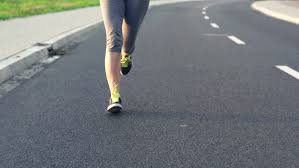You’re excited! You’ve decided to start a walking program and are ready to launch out on the streets and sidewalks around your house. Or you’re headed to the local recreation facility to pad around their indoor track.
You’re off to a great start!
Or are you?
Setting a walking goal to improve fitness, and reduce injury risk—
Would you like to start a walking program, one that improves your fitness level and reduces your risk of injury? If you answered “yes,” then let’s get started!
If you haven’t read my previous post, May 23—“How to Begin an Effective Walking Program Part 1” http://andreaarthurowan.com/2018/05/23/209/blog, on choosing the right shoes, then make sure you do that first. Then grab a journal and start planning your 12-week program.
Follow These Steps to an Effective Program—
- Aim to walk at least 5 days a week. (I’m a proponent of taking a day off, so I walk 6 days out of 7. While casual walking on Day 7 is okay, your body will appreciate a brisk-walk break.)
- Always start out with slow stretching for your legs, knees and Achilles tendons.
It’s best if you can do some light calisthenics prior to stretching, so you can get the blood moving, and the body warm, which makes the muscles more responsive to stretching.
- Make the first 5 minutes of your walk a slower pace, so your heart has some time to respond. Don’t blast off like a race horse out the gates.
- Make your goal a brisk pace.
How is brisk defined? Brisk is defined as a 3 – 4 miles per hour pace. That’s moving at a pretty decent clip, with you breathing deeply while still being able to carry on a conversation.
Don’t worry if you can’t do the brisk walk right away. If you must, work up to it slowly.
- To avoid injury, plan to increase your walking pace by 10% a week, OR increase your mileage by 10%, BUT NOT BOTH!
This is where I probably differ with the National Heart, Lung and Blood Institute, that advocates increasing your walking time by 2 minutes every week.
To avoid acute, or chronic (long-term) injury, I insisted that my athletes and patients follow this 10% rule.
Let’s say you’re able to warm-up, and then walk a mile, followed by a cool down your first time out. You feel pretty peachy and proud of yourself. And you’re really tempted to push it to over one mile the next day out.
Don’t do it! Continue with your one-mile distance for that week, without pushing the speed up, either. Be patient, and give your body time to respond, without unduly stressing those previously dormant muscles, tendons and ligaments.
So many of my regular patients and competitive athletes tried to push through (or defy) this rule, and they ended up having chronic injuries that were difficult, if not impossible to heal. Better to take it slowly—and avoid injury—than have to back up, treat a persistent problem, and park it back on the couch for six weeks.
The following week, increase your mileage by 10% (to 1.1 miles) OR increase your pace by 10%, to 3.3 miles per hour.
By using that format, you can see where, as your mileage gets higher, your mileage jumps up very quickly. If you’re walking 4 miles and then increase that 10%, you’ll jump to 4.4 miles the following week.
Sometimes it takes longer than a week to move up another 10%, but don’t try to defy or ignore the one-week rule. Pay attention to how your body feels and is responding before deciding whether or not to increase your mileage OR your pace.
- Remember to keep track of your heart rate!
You may want to use your smart phone, or another fitness device, like a Fitbit to track your heart rate and blood pressure. If you’re aiming for a moderate (or a little more) cardio workout, you would want to stay in a 50 – 70% target heart rate range for the entire brisk walk phase.
(Please see my post http://andreaarthurowan.com/2018/04/25/the-best-way-to-calculate-your-exercise-training-heart-rate/admin/
to properly calculate your training heart rate using your resting heart rate as a guideline!)
- Do not sit down after your walk until you’ve slowed to a heart rate-reducing pace walk and performed 5 minutes of stretching.
It’s stressful on your heart to just stop exercising, without continuing to move around and “cool” down, so keep a leisurely pace until your heart rate drops to a comfortable level. It should begin to drop immediately after you reduce your pace.
And with all of that accumulated lactic acid making your legs feel heavy, and the flowing blood, puffed up tissues and muscles and on-alert nerves, you need to try to get it flowing out of the limbs so they can recover.
Contrary to popular opinion, lactic acid does not cause pain. It causes a heavy feeling and sluggishness. The blood and squeezing of nerves and vessels from muscle contraction can cause the pain. Elevating the legs for twenty minutes after exercise, or light massage with hand movement toward the heart (not toward the feet) can help with this.
And ice any joint or tissue that feels any pain twinge for 20 minutes. Make note of that in your journal.
- Set your goal for 40 minutes of walking 5 -6 days a week, including a 5-minute warm-up (after stretching) and a 5-minute cool-down.
The National Heart, Lung, and Blood Institute chart says you should be reaching that by week 12. If you don’t, don’t worry. Just keep at it—consistently—until you do.
It’s very important to be consistent. Rain or shine. Hot weather or cold. If you miss a couple of days, it usually isn’t a problem. If you miss a week, you may need to work back up to the level where you stopped before the blank week. If you’re over 50, your fitness level zooms downhill like a fast-moving roller coaster, so try as hard as you can to stay with it and be consistent!
- Aim for walking outside!
For a variety of reasons, fresh air is the best environment in which to walk. But if you don’t have a fresh air supply—because you live in the city—then find an indoor track to pad around. Or get on a treadmill in the gym. Treadmills are always a nice option because they can increase the exercise level with hill-like ramping capability.
- If you do walk outside, alter the direction you walk every day!
Ever been walking in an indoor track or rec facility track where they have you walk clockwise one day and then counter-clockwise the next? There’s a good reason for that, one you need to consider when you’re walking out on a road.
Another common problem I saw in my patients and athletes, especially runners, was chronic injury on their “downhill or inside leg.” The leg that always ended up closest to the curb on a street.
The problem arises from the fact that when you’re always running or walking the same direction, one leg is almost always having to compensate for a roadway that curves down toward the gutter, or curves inside toward the track. Day after day after day of that is stressful on the body. Change directions to keep your lower limbs from chronic stress. (The uphill leg isn’t happy about it, either.)
One problem with running or walking on a road, though, is that you should always walk against the traffic. That way they can see you. (Cyclists are to ride with the traffic flow, not against it. Just the opposite of a walker.)
So there you go! Ten tips for setting up a successful walking program.
But we’re not done!
In the future, we’ll look at when walking outside isn’t a good option, and what to do when you’ve reached your 40 minutes and start feeling as though you’ve hit a workout wall.
If you need some additional guidance, drop me an email at andreaarthurowan@gmail.com. Or leave a comment to let me know how you’re doing with the program.
And if you think this post might be helpful for someone you know, please share it!
NEXT WEEK: When you really shouldn’t be walking outside!
Until then,
Happy walking!
Andrea
May you prosper in all things and be in health, just as your soul prospers (3 John 2).
*The advice in this blog is not meant to be a substitute for a physician’s recommendation or treatment plan!
NOTE: If you have serious health issues, are on medications, or are over 40 and have been sedentary for a while, make sure you see your doctor first for approval or special recommendations.
Photo courtesy of Andrea A. Owan










 Arthur Schopenhauer (1788 – 1860) A German philosopher, like Hegel, Schopenhauer is considered to be a true pessimist. He believed life is evil to the core, and pain and suffering are unavoidable. He is the father of Existentialism, although the Merriam-Webster Dictionary defines Existentialism as chiefly a 20th Century philosophy.
Arthur Schopenhauer (1788 – 1860) A German philosopher, like Hegel, Schopenhauer is considered to be a true pessimist. He believed life is evil to the core, and pain and suffering are unavoidable. He is the father of Existentialism, although the Merriam-Webster Dictionary defines Existentialism as chiefly a 20th Century philosophy. Soren Kierkegaard (1813 – 1855) Kierkegaard, a Dane and deeply religious thinker, believed that God’s existence cannot be proven. But he believed that a religious leap of faith could make our lives bearable and meaningful. He is regarded as a Theist—someone who believes in a God as the creative source of the human race and the world who transcends the world but is immanent (being within the limits of possible experience or knowledge) in it. Most theists regard God as a creator who stands back from His creation without getting too involved it.
Soren Kierkegaard (1813 – 1855) Kierkegaard, a Dane and deeply religious thinker, believed that God’s existence cannot be proven. But he believed that a religious leap of faith could make our lives bearable and meaningful. He is regarded as a Theist—someone who believes in a God as the creative source of the human race and the world who transcends the world but is immanent (being within the limits of possible experience or knowledge) in it. Most theists regard God as a creator who stands back from His creation without getting too involved it.
 John Dewey (1859 – 1952) An American! Dewey was considered to be a pragmatist—someone guided by practicality and that “the function of thought is to guide action.” He considered democracy to be a way of life, and that democracy should be promoted and pursued by a rational and effective educational system. Dewey has had a profound impact on both the American educational and political systems.
John Dewey (1859 – 1952) An American! Dewey was considered to be a pragmatist—someone guided by practicality and that “the function of thought is to guide action.” He considered democracy to be a way of life, and that democracy should be promoted and pursued by a rational and effective educational system. Dewey has had a profound impact on both the American educational and political systems. Albert Camus (1913 – 1960) Camus was an atheist who was an existentialist. He believed humans must establish their own dignity, despite a meaningless life.
Albert Camus (1913 – 1960) Camus was an atheist who was an existentialist. He believed humans must establish their own dignity, despite a meaningless life. C.S. Lewis (1898 – 1963) A former atheist, the British and Oxford don, Lewis, became the greatest Christian apologist of the 20th Century. He is the esteemed author of the famous Chronicles of Narnia series, as well as Mere Christianity, and was a close friend of the Lord of the Rings trilogy author, J.R.R. Tolkien. Both men were members of the Inklings, an informal literary discussion group associated with Oxford, England.
C.S. Lewis (1898 – 1963) A former atheist, the British and Oxford don, Lewis, became the greatest Christian apologist of the 20th Century. He is the esteemed author of the famous Chronicles of Narnia series, as well as Mere Christianity, and was a close friend of the Lord of the Rings trilogy author, J.R.R. Tolkien. Both men were members of the Inklings, an informal literary discussion group associated with Oxford, England.